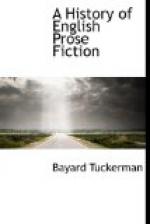The ideal character of the yeomanry succeeded to the ideal character of the knighthood; Robin Hood and his merry companions took the place in the popular mind which belonged to King Arthur and his knights of the Table Round. The yeomen of England were imbued with a spirit of courage and liberty unknown to the same class on the continent of Europe, and their love of freedom and restless activity of disposition found a reflection in the person of their hero. Supposed to have lived in the thirteenth century, his name and achievements have been sung in countless rhymes and ballads, and have remained dear to the common people down to the present day. The patron of archery, the embodiment of the qualities most loved by the people—courage, generosity, faithfulness, hardihood,—the places he frequented, the well he drank from, have always retained his name, and his bow, with one of his arrows, was preserved with veneration as late as the present century.[28] The ideal of the yeomanry was similar to that of chivalry in the love of blows fairly given and cheerfully taken, in the love of fighting for fighting’s sake. It was similar in the courtesy which was always a characteristic of Robin Hood; in the religious devotion which caused the outlaw to hear three masses every morning before setting out on his depredations; in the gallantry which restrained him from molesting any party which contained a woman.[29] But the tales relating to Robin Hood differ from those of the Round Table in their entire freedom from affectation and from supernatural machinery. They breathe, too, an open-air spirit of liberty and enjoyment which was pleasing and comprehensible to the dullest intellect, and which made them, in the broadest sense, popular. The good-humored combativeness of the yeoman sympathized with every beating which Robin Hood received, and with every beating which he gave. In Robin’s enmity to the clergy, in his injunction to his followers,
“Thyse byshopppes
and thyse archebyshoppes,
Ye shall them
bete and bynde,”
the people applauded resistance to the extortion of the church. In Robin’s defiance of the law and its officers, they applauded resistance to the tyranny of the higher classes. Waylaying sheriffs and priests, or shooting the king’s deer in Sherwood Forest, the famous outlaw and his merry men, clad all in green, were the popular heroes. On Robin Hood’s day the whole population turned gaily out to celebrate his festival, never weary of singing or hearing the ballads which commemorated his exploits. Robin was a robber, but in times of disorder highway robbery has always been an honorable occupation, and the outlaws of Sherwood Forest were reputed to give to the poor what they took from the rich. Diligent enquiries have been made to ascertain whether the personage known as Robin Hood had a real existence, but without positive results. The story of his life is purely legendary, and the theories in regard to him have never advanced beyond hypothesis.




